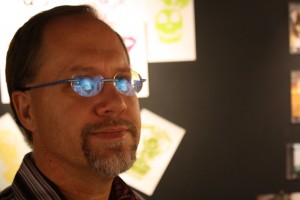Creativity Runs Rampant In John Midby's Room 13 At Foshay
At first glance, 13-year-old Jasmine Taylor resembles a quintessential South Central Los Angeles middle school student.
As she escorts a pair of captivated couples through the Hold Up Art Gallery on East 2nd Street, Taylor confidently discusses canvas choices, color schemes and photography. What distinguishes Taylor and her classmates from their peers is the way they will spend their free time this December – as docents for their class's self-produced art collection displayed in downtown Los Angeles.
“Photography is my way of expressing myself,” Taylor said. “I like painting and all other types of art, but photography… it’s my life. But, I couldn’t do it without our Room 13.”

Taylor is one of 170 students involved in Room 13, a student managed and financed, multi-media studio at the James A. Foshay Learning Center in South Central L.A. One of only 83 similarly designed student-driven art studios worldwide, the Room 13 alternative classroom model focuses on original, creative learning and problem solving within a public school context, providing students with the necessary tools to become professional artists.
“Room 13 is the complete opposite of a LAUSD program or any traditional education program,” said John Midby, founder of Foshay’s Room 13 program. “It’s not a franchise, where they bring you the paperwork and you repeat the language and repeat after them. You come up with a system that fits within your school culture, where students and adults can create an art studio and business model.”
Teaching five classes daily to students from 6th grade through high school, Midby launched the first Room 13 program in North America three years ago, encouraging his students to both pursue personal expression through art and explore sustainable business models. When he’s not teaching, Midby is working overtime planning fundraising events, workshops and exhibitions during is conference periods and after school to help fund the self-sustaining studio.
“John [Midby’s Room 13] classroom really gives our students a chance to see how artists make a living and how to run a successful business,” said Foshay’s Principal, Yvonne Edwards. “He is so committed, and his sense of commitment and expectations for his students have made them rise to the occasion.”

Beginning his career as an independent filmmaker, Midby used substitute teaching to support his cinematic endeavors until becoming a full-time English teacher eight years ago. After helming a study on highly effective teaching methods, Midby was approached with the idea of starting a Room 13 classroom.
“It’s more like being a coach because the students can call the plays also,” Midby said. “I’m letting them know what the possibilities are, what Room 13 is, and then together, we figure out what we are doing day-to-day.”
To help guide students in their artistic discovery, Midby enlists the help of local artists and past Room 13 graduates to both inspire and mentor students. His students engage in virtually every conceivable artistic medium, from painting and stencils, to photography, video and even journalism.
Rogelio Santana – an 11th grader in Midby’s high school period of Room 13 – considers Midby his most attentive teacher, constantly thinking about his students and encouraging them to vehemently pursue what they are passionate about.
“He gave me the ride [to the exhibition] tonight. Without him, I probably wouldn’t have come,” Santana said. “He’s always trying to make me go to other places to learn more about art.”
The Room 13 model encourages each classroom to be self-sustaining and to be led by a student management team, responsible for decision-making and the implementation of the business model.
“The goal of the class is to support itself,” Midby said. “We do everything from appearing at farmer’s markets, to doing collaborative workshops and exhibitions. About ten percent of the time, we have to do things like sell pizza… but for the most part, we’re putting on exhibitions and selling our art.”
Midby and his students continue to lead a number of art workshops in South Los Angeles, teaching children and community members how to make recycled art and silkscreen original designs on T-shirts. In the classroom, Midby is part teacher, part producer, giving his students the agency halfway through the school year to plan their own class time. At this point in the school year, Midby’s five classes are far beyond strict lesson plans.
“One of the main things that I teach them is that the image is an idea, and the image and idea can come in any form,” Midby said. “It could have started off as a painting and it can end up as a sticker or a poster. But the design is forever.”
Although Foshay boasts comparatively high Academic Performance Index (API) score for the South Central L.A. area at 657, its scores fell under the district average of 709. The figure summarizes a school’s performance on the 2010 California State Standardized Testing and Reporting Program (STAR) and the 2010 California School Exit Examination (CAHSEE) tests.

“The neighborhood is kind of in flux… it’s really a Mecca for them in the neighborhood,” Edwards said. “There are a lot of houses, mostly single-family homes and very few apartments around the school. So you have people who are committed to their families.”
A community whose population used to be predominantly African American, the demographic breakdown of the area of South Central L.A. surrounding Foshay is now more than 50 percent Latino, according to recent US census data.
In spite of renovations to the area and construction projects – such as the Metro Rail construction along Expedition Blvd. – the median value of homes in the area remains more than $150,000 less than the median value of the rest of California, which is $217,082.
Despite it’s location, Foshay is considered a more effective than average school, according to the LA-Time’s “value-added” analysis. The analysis is a statistical method that estimates the effectiveness of an LAUSD teacher or school by looking at the standardized test scores of students.
With more than 1,000 LAUSD employees losing their jobs earlier this month, Midby said he watched a number of qualified teachers, classroom aides and campus employees at Foshay lose their jobs. Although skeptical of the recently published LA-Times study on teachers’ performance in the classroom, he considers the project a necessary step in a tough economic climate.
“Whether they publish this in the LA-Times or not, every good teacher hates the fact that the union protects lousy teachers… hates it,” Midby said. “Why should the ones of us who work so hard have to see and work with other people who obviously don’t care?”

In lieu of recent layoffs to a number of LAUSD teachers, Midby said the system has lost a number of talented teachers whilst retaining some who, in his opinion, should have moved on to another profession.
“The problem has always been that [teacher’s] union [UTLA] has gone too far in protecting teachers,” Midby said. “Because of this, the district has had no viable way to separate bad teachers from good ones. When there are a bunch of cuts, it just increases the percentage of teachers who don’t really care about what they are doing.”
A number of class’s pieces will continue to be shown until January 8 at the “Gift of Art” exhibition housed at the Hold Up Art Gallery. Presented in conjunction with the Los Angeles Museum of Contemporary Art (MOCA), the exhibition will feature art by Room 13 students alongside that of prominent L.A. artists, such as Bill Farroux, Chor Boogie, Ernesto Yerena, Kathia Dungplata, Magda Audifred, Mear One, Pep Williams, Philip Lumbang, Shark Toof, Steven Lopez and Timoi, the class’s artist-in-residence.
“The whole show is about the artists who helped influence these kids and their understanding of what contemporary art is,” said Brian Lee, founder of Hold Up Art Gallery. “Half the gallery’s profits from the show will go to support Room 13.”
For Midby, Foshay’s Room 13 artists represent the Los Angeles of today – young, expressive, multi-racial and creative.
“I just want them to see that you can do things even from the 6th grade that no one else can do and that other people are going to respect,” Midby said. “I tell my students, you can engineer your fate. You can pick what you want to do in your life, and you can accomplish it.”



